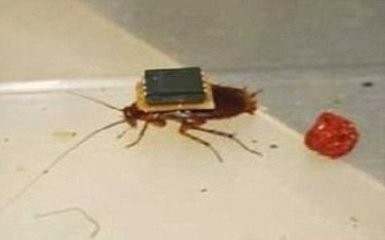Archives
March 2, 2010
Cockroaches, Backpacks & National Security
Great use of the cockroach (ugh), although for purposes of radiation detection, perhaps we should use the two-legged kind as well?!
National Defense Magazine | March 2010
Backpack-Wearing Cockroaches To Detect Radiation
By Austin Wright

The creature that's expected to inherit the Earth following a nuclear
holocaust might also be well suited to help prevent man's atomic
self-destruction.
Researchers at Texas A&M University’s Nuclear Security Science and Policy Institute have attached radiation sensors to the backs of cockroaches. They hope public-safety officials will one day send the souped-up insects into situations that are too risky for humans.
“Cockroaches really are the perfect medium for this,” says William Charlton, an associate professor of nuclear engineering at the university and a principal investigator on the project. “They can go for extraordinarily long periods of time without food. They exist on every continent except Antarctica. They’re very radiation resistant, and they can carry extremely large amounts of weight compared to their body mass.”
He envisions teams of about 20 remotely-controlled roaches - each carrying one of three types of sensors meant to detect different nuclear materials - that would march through areas of up to a square kilometer and send their readings back to an operatorvia a tiny, low-energy communications system. This would help officials determine if potentially contaminated areas - such as buildings where they suspect terrorists have planted a dirty bomb - are safe for humans.
The operator will be able to manipulate the insects’ forward and directional movements - cockroaches can’t crawl backward - using devices that apply pressure to parts of their antennas and stimulate their leg muscles. “It’s like a cattle prod for cockroaches,” Charlton says.
Five faculty members and about six graduate students at the institute are working on the project, which is funded by the National Science Foundation. They’re now designing sensors and communications systems that are small enough to fit on a roach’s back, and both devices will use low-energy circuits that could also be installed in cell phones and hand-held computers.
The team originally planned to build bug-like robots, but they soon found that the motor functions consumed too much power. “A biological platform doesn’t take any power to move,” Charlton says. “That really was the breakthrough in the program.”
Cockroaches can run tirelessly for 35 minutes, according to a university document describing the system. And the resilient insect can carry a 3-gram load for months.
Original article here.
Log In »
Notable Quotables
"Mr. Netanyahu is one of the most media-savvy politicians on the planet. On Friday he appeared live via video link on 'Real Time with Bill Maher,' taking the host’s alternately sardonic and serious line of questioning with gazelle-like alacrity."
~ Anthony Grant, jourrnalist who has written for many major newspapers and worked in television at Paris and Tel Aviv, interviewing former PM Benjamin Netanyahu on Monday, at the outset of Mr. Netanyahu's new book (more here).


